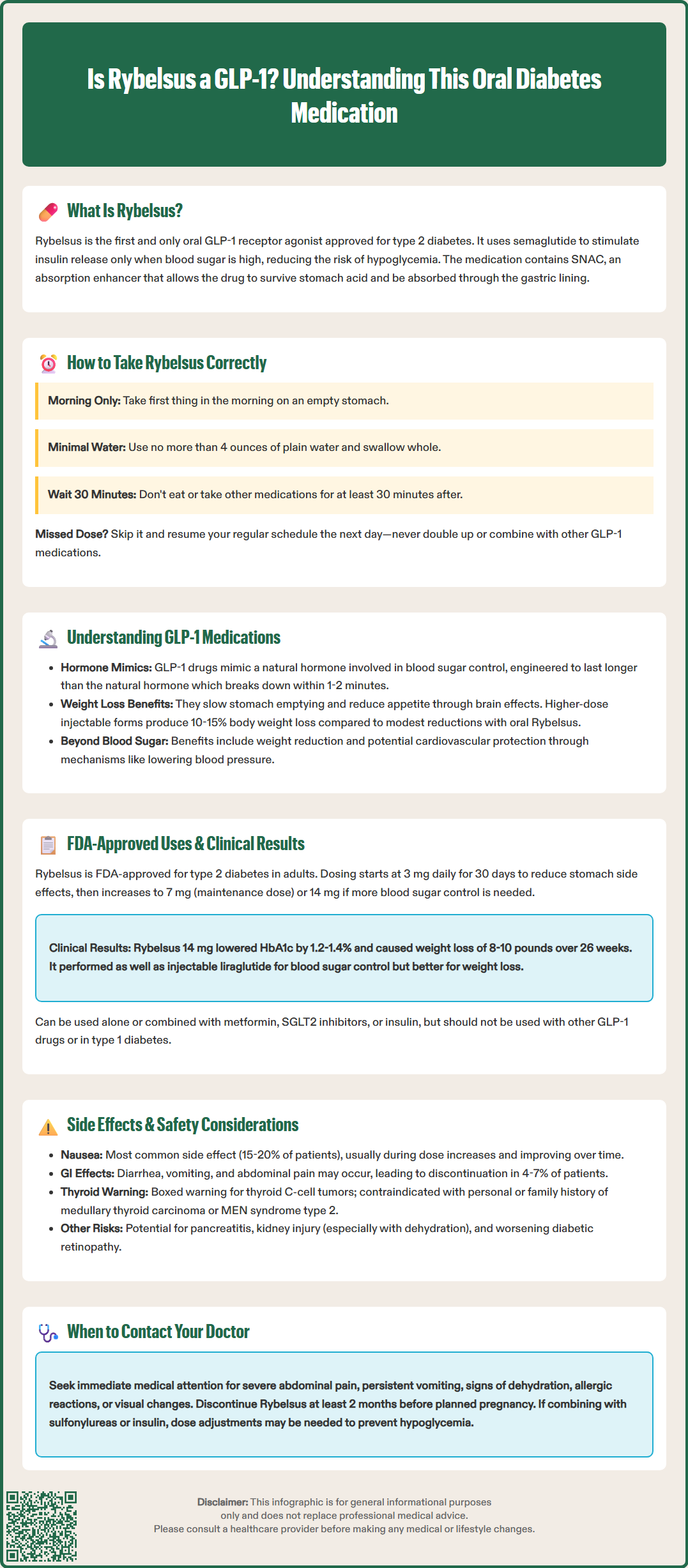LOSE WEIGHT WITH MEDICAL SUPPORT — BUILT FOR MEN
- Your personalised programme is built around medical care, not willpower.
- No generic diets. No guesswork.
- Just science-backed results and expert support.
Find out if you’re eligible

Rybelsus (semaglutide) is a GLP-1 receptor agonist and represents a significant advancement in type 2 diabetes treatment as the first oral medication in this therapeutic class. Approved by the FDA in 2019, Rybelsus mimics naturally occurring glucagon-like peptide-1 hormones to improve blood sugar control through multiple mechanisms, including stimulating glucose-dependent insulin secretion and suppressing excessive glucagon release. Unlike injectable GLP-1 medications, Rybelsus offers the convenience of once-daily oral administration, though it requires specific dosing instructions to ensure proper absorption. Understanding how this medication works, its clinical benefits, and important safety considerations helps patients and healthcare providers make informed treatment decisions.
Quick Answer: Rybelsus (semaglutide) is a GLP-1 receptor agonist and the first oral medication in this class approved for type 2 diabetes management.
Rybelsus (semaglutide) is indeed a GLP-1 receptor agonist, specifically the first and only oral formulation of this medication class approved for type 2 diabetes management. The active ingredient, semaglutide, is a glucagon-like peptide-1 (GLP-1) analog that mimics the action of naturally occurring GLP-1 hormones in the body.
The medication works through multiple complementary mechanisms to improve glycemic control. Semaglutide binds to and activates GLP-1 receptors located primarily in pancreatic beta cells, stimulating glucose-dependent insulin secretion. This means insulin release occurs only when blood glucose levels are elevated, reducing the risk of hypoglycemia compared to some other diabetes medications. Simultaneously, Rybelsus suppresses inappropriately elevated glucagon secretion, which helps prevent excessive hepatic glucose production.
What makes Rybelsus unique among GLP-1 receptor agonists is its oral delivery system. The tablet contains an absorption enhancer called sodium N-(8-[2-hydroxybenzoyl] amino) caprylate (SNAC), which facilitates absorption of semaglutide across the gastric mucosa. This innovation addresses the traditional challenge of delivering peptide-based medications orally, as they typically degrade in the acidic stomach environment. Patients must take Rybelsus first thing in the morning on an empty stomach with no more than 4 ounces of plain water only, swallow the tablet whole (do not split, crush, or chew), and wait at least 30 minutes before consuming food, beverages, or other medications to ensure optimal absorption. If a dose is missed, patients should skip it and take the next scheduled dose the following day. Rybelsus should not be used with other GLP-1 receptor agonists or other semaglutide-containing products. The delayed gastric emptying effect of Rybelsus may affect the absorption of other oral medications, which may be clinically relevant for drugs with a narrow therapeutic index.
GLP-1 receptor agonists represent a therapeutic class of medications that enhance the activity of the incretin hormone system, which plays a fundamental role in glucose homeostasis. Endogenous GLP-1 is secreted by intestinal L-cells in response to nutrient intake and has a half-life of only 1-2 minutes due to rapid degradation by the enzyme dipeptidyl peptidase-4 (DPP-4). Pharmaceutical GLP-1 receptor agonists like semaglutide are engineered to resist DPP-4 degradation, providing sustained therapeutic effects.
Beyond glycemic control, GLP-1 receptor agonists exert clinically significant effects on body weight and cardiovascular outcomes. These medications slow gastric emptying, which prolongs satiety and reduces appetite through central nervous system pathways. The weight reduction observed with GLP-1 therapy is not merely a side effect but represents a therapeutic benefit for many patients with type 2 diabetes, who often struggle with overweight or obesity. In clinical trials, Rybelsus 14 mg typically produced modest weight loss of a few kilograms. The more substantial weight reductions of 10-15% of body weight have been observed with higher-dose injectable semaglutide (2.4 mg) used specifically for obesity treatment, not with the Rybelsus formulation.
The American Diabetes Association (ADA) Standards of Care recommend specific GLP-1 receptor agonists with proven cardiovascular benefit (injectable semaglutide, liraglutide, and dulaglutide) for patients with type 2 diabetes who have established atherosclerotic cardiovascular disease or indicators of high cardiovascular risk. It's important to note that Rybelsus does not have an FDA indication for cardiovascular risk reduction. The potential cardioprotective mechanisms of certain GLP-1 receptor agonists may involve improvements in glycemic control, weight reduction, blood pressure lowering, and possibly other effects on vascular function, though the exact mechanisms continue to be studied.

The FDA approved Rybelsus in September 2019 as an adjunct to diet and exercise to improve glycemic control in adults with type 2 diabetes mellitus. It is available in three tablet strengths: 3 mg, 7 mg, and 14 mg. The typical initiation regimen begins with 3 mg once daily for 30 days, primarily to improve gastrointestinal tolerability rather than for glycemic efficacy. After this period, the dose is increased to 7 mg daily, which serves as the maintenance dose for many patients. If additional glycemic control is needed after at least 30 days on the 7 mg dose, escalation to 14 mg once daily may be considered.
Clinical trial data from the PIONEER program demonstrated robust efficacy for Rybelsus across multiple studies. In the PIONEER 1 trial, oral semaglutide 14 mg reduced HbA1c by approximately 1.2-1.4% from baseline, with significant proportions of patients achieving HbA1c targets below 7%. The PIONEER 4 trial showed that oral semaglutide was noninferior to liraglutide (another GLP-1 receptor agonist) for HbA1c reduction but superior for weight loss, and superior to placebo for both outcomes. Patients treated with Rybelsus 14 mg experienced mean weight reductions of 8-10 pounds over 26 weeks in various trials.
Rybelsus can be used as monotherapy or in combination with other antidiabetic medications, including metformin, sulfonylureas, sodium-glucose cotransporter-2 (SGLT2) inhibitors, and insulin. However, it should not be used in patients with type 1 diabetes or for treatment of diabetic ketoacidosis, and should not be coadministered with other GLP-1 receptor agonists or semaglutide-containing products. According to current ADA Standards of Care, therapy selection should be individualized based on comorbidities, weight considerations, hypoglycemia risk, and patient preferences. While metformin remains common initial therapy, GLP-1 receptor agonists may be appropriate first-line therapy in selected patients, particularly those with cardiovascular disease, heart failure, or chronic kidney disease.
The most frequently reported adverse effects of Rybelsus involve the gastrointestinal system, consistent with the class effects of GLP-1 receptor agonists. Nausea occurs in approximately 15-20% of patients and represents the most common side effect, typically emerging during dose escalation and often diminishing over several weeks as tolerance develops. Other gastrointestinal effects include diarrhea (9-10%), vomiting (8-9%), constipation, abdominal pain (6-8%), and decreased appetite (5-7%). These effects are generally mild to moderate in severity, but they can lead to treatment discontinuation in approximately 4-7% of patients.
Serious safety considerations require careful patient selection and monitoring. Rybelsus carries a boxed warning regarding the risk of thyroid C-cell tumors, based on rodent studies showing dose-dependent and treatment-duration-dependent increases in thyroid C-cell tumors. While the relevance to humans remains uncertain, Rybelsus is contraindicated in patients with a personal or family history of medullary thyroid carcinoma (MTC) or in patients with Multiple Endocrine Neoplasia syndrome type 2 (MEN 2). Routine calcitonin or thyroid ultrasound monitoring is not recommended for MTC detection. Patients should be counseled to report symptoms of thyroid tumors, including a neck mass, dysphagia, dyspnea, or persistent hoarseness.
Additional safety concerns include acute pancreatitis, which has been reported with GLP-1 receptor agonists. Patients should discontinue Rybelsus immediately if pancreatitis is suspected and should not resume treatment if confirmed. The medication may increase heart rate by approximately 2-4 beats per minute, warranting monitoring in patients with cardiac conditions. Acute kidney injury has been reported, particularly in patients experiencing severe gastrointestinal adverse reactions with volume depletion. Hypoglycemia risk increases when Rybelsus is combined with insulin secretagogues like sulfonylureas or with insulin; dose reductions of these concomitant medications may be necessary. Diabetic retinopathy complications have been reported in patients with pre-existing diabetic retinopathy, particularly with rapid improvement in glycemic control. Gallbladder disease (cholelithiasis, cholecystitis) has been reported with GLP-1 receptor agonists, including semaglutide; patients should seek medical attention for right upper quadrant pain, fever, or jaundice. Serious hypersensitivity reactions, including anaphylaxis and angioedema, have occurred. Rybelsus is not recommended during pregnancy and should be discontinued at least 2 months before a planned pregnancy. Patients should be advised to seek immediate medical attention for severe abdominal pain, persistent vomiting, signs of dehydration, allergic reactions, or visual changes while taking Rybelsus.
Rybelsus is the first and only oral GLP-1 receptor agonist, while other GLP-1 medications require injection. It contains an absorption enhancer (SNAC) that allows the medication to be absorbed through the stomach lining, but requires specific administration instructions including taking it on an empty stomach with limited water and waiting 30 minutes before eating or taking other medications.
The most common side effects are gastrointestinal, including nausea (15-20% of patients), diarrhea (9-10%), vomiting (8-9%), and abdominal pain (6-8%). These effects typically occur during dose escalation and often diminish over several weeks as the body adjusts to the medication.
Rybelsus is contraindicated in patients with a personal or family history of medullary thyroid carcinoma or Multiple Endocrine Neoplasia syndrome type 2 (MEN 2). It should not be used in patients with type 1 diabetes, for diabetic ketoacidosis treatment, or in combination with other GLP-1 receptor agonists or semaglutide-containing products.
All medical content on this blog is created using reputable, evidence-based sources and is regularly reviewed for accuracy and relevance. While we strive to keep our content current with the latest research and clinical guidelines, it is intended for general informational purposes only.
This content is not a substitute for professional medical advice, diagnosis, or treatment. Always consult a licensed healthcare provider with any medical questions or concerns. Use of this information is at your own risk, and we are not liable for any outcomes resulting from its use.